Critical Evaluation of Evidence: Stimulants and Academic Performance
VerifiedAdded on 2020/03/16
|12
|2850
|290
Report
AI Summary
This report critically evaluates two articles concerning the use of stimulants to enhance academic performance. The first article, by Hildt et al., explores students' experiences and the effects of stimulant use, while the second, by Munro et al., analyzes the relationship between nonmedical stimulant use, executive functioning, and academic outcomes. The report assesses the strengths and weaknesses of each study, discusses barriers to applying research findings in practice, such as lack of time and resources, and examines how closely the studies align with the PICO framework. The report concludes that while stimulants may improve awareness and motivation, there is no conclusive evidence that they directly enhance academic performance and highlights the importance of critical appraisal skills in healthcare.
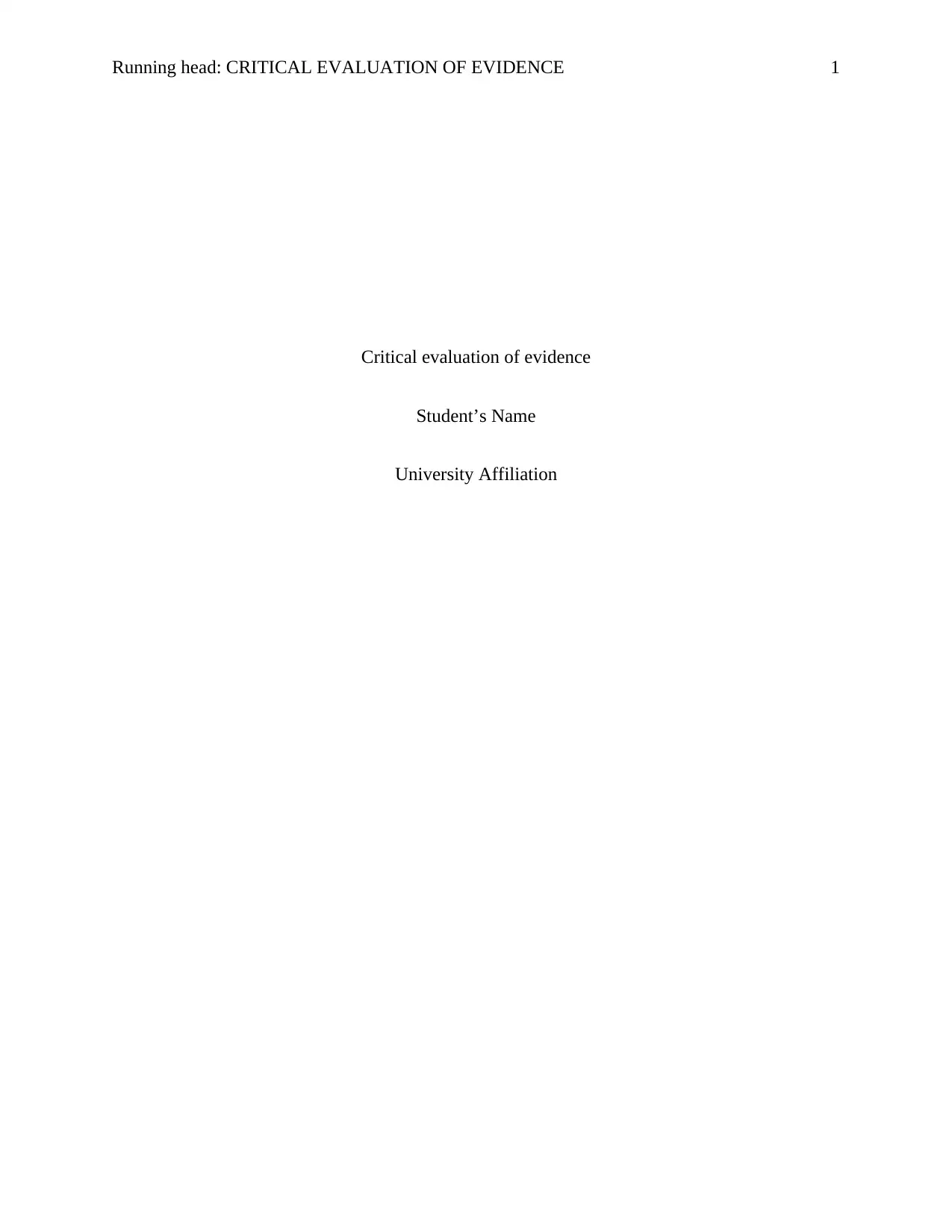
Running head: CRITICAL EVALUATION OF EVIDENCE 1
Critical evaluation of evidence
Student’s Name
University Affiliation
Critical evaluation of evidence
Student’s Name
University Affiliation
Paraphrase This Document
Need a fresh take? Get an instant paraphrase of this document with our AI Paraphraser
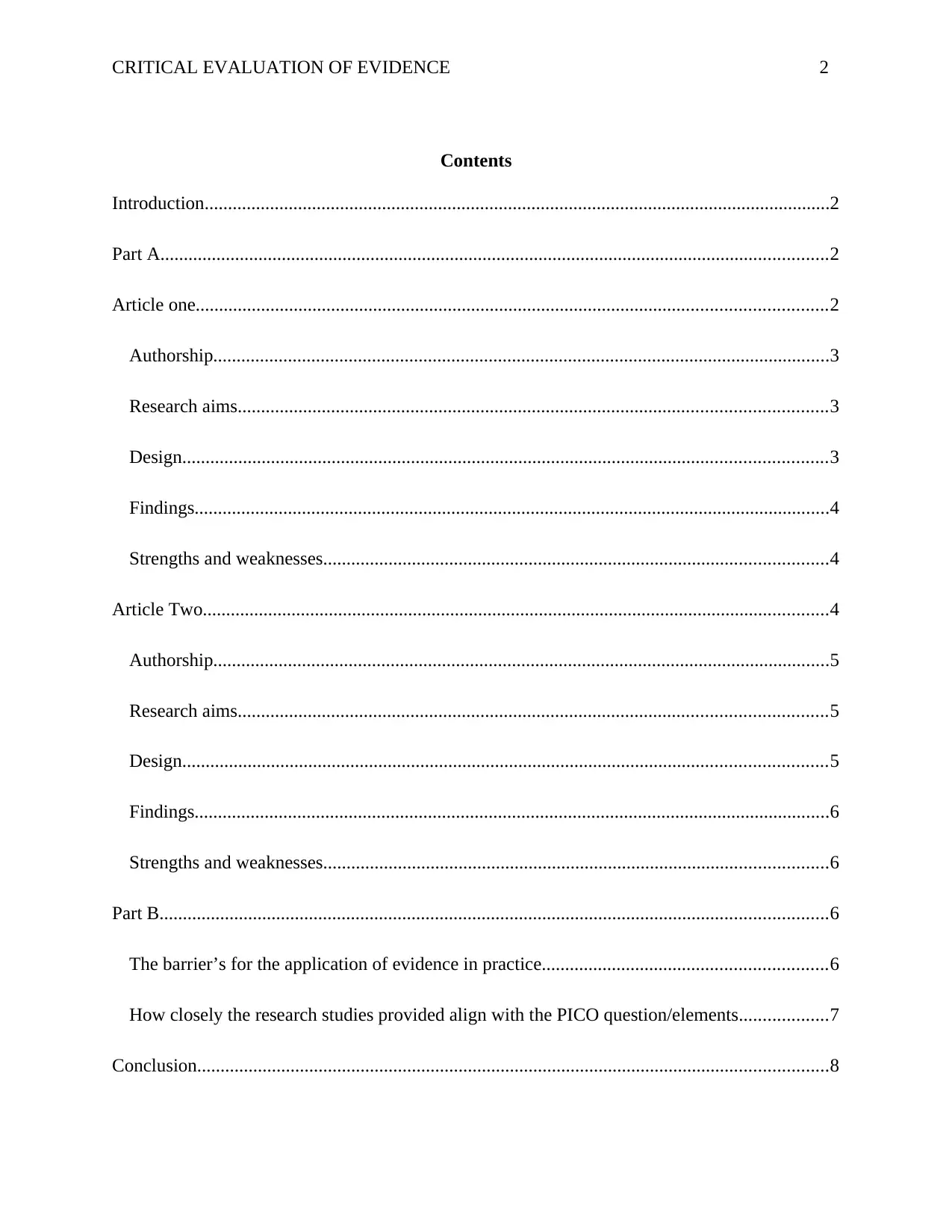
CRITICAL EVALUATION OF EVIDENCE 2
Contents
Introduction......................................................................................................................................2
Part A...............................................................................................................................................2
Article one.......................................................................................................................................2
Authorship....................................................................................................................................3
Research aims..............................................................................................................................3
Design..........................................................................................................................................3
Findings........................................................................................................................................4
Strengths and weaknesses............................................................................................................4
Article Two......................................................................................................................................4
Authorship....................................................................................................................................5
Research aims..............................................................................................................................5
Design..........................................................................................................................................5
Findings........................................................................................................................................6
Strengths and weaknesses............................................................................................................6
Part B...............................................................................................................................................6
The barrier’s for the application of evidence in practice.............................................................6
How closely the research studies provided align with the PICO question/elements...................7
Conclusion.......................................................................................................................................8
Contents
Introduction......................................................................................................................................2
Part A...............................................................................................................................................2
Article one.......................................................................................................................................2
Authorship....................................................................................................................................3
Research aims..............................................................................................................................3
Design..........................................................................................................................................3
Findings........................................................................................................................................4
Strengths and weaknesses............................................................................................................4
Article Two......................................................................................................................................4
Authorship....................................................................................................................................5
Research aims..............................................................................................................................5
Design..........................................................................................................................................5
Findings........................................................................................................................................6
Strengths and weaknesses............................................................................................................6
Part B...............................................................................................................................................6
The barrier’s for the application of evidence in practice.............................................................6
How closely the research studies provided align with the PICO question/elements...................7
Conclusion.......................................................................................................................................8
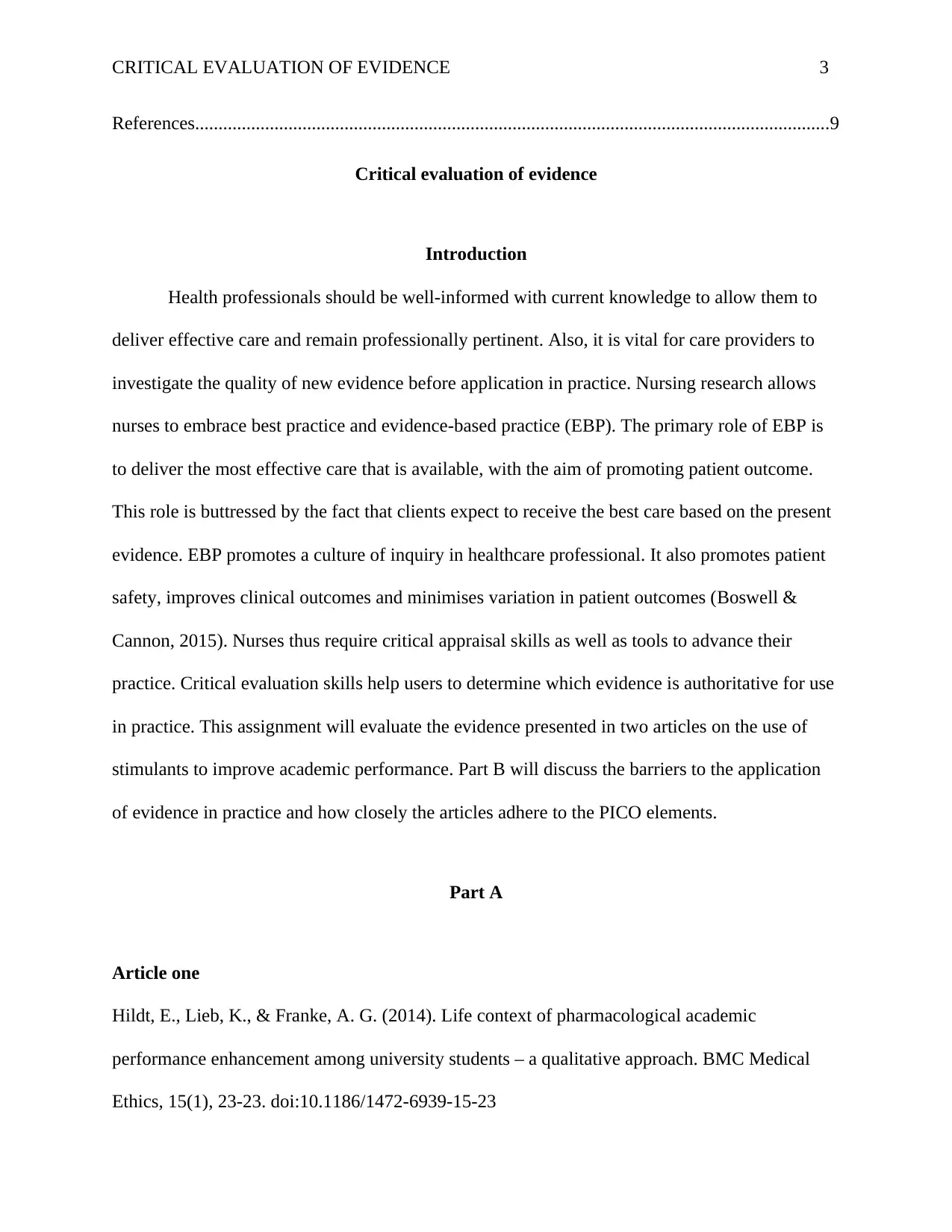
CRITICAL EVALUATION OF EVIDENCE 3
References........................................................................................................................................9
Critical evaluation of evidence
Introduction
Health professionals should be well-informed with current knowledge to allow them to
deliver effective care and remain professionally pertinent. Also, it is vital for care providers to
investigate the quality of new evidence before application in practice. Nursing research allows
nurses to embrace best practice and evidence-based practice (EBP). The primary role of EBP is
to deliver the most effective care that is available, with the aim of promoting patient outcome.
This role is buttressed by the fact that clients expect to receive the best care based on the present
evidence. EBP promotes a culture of inquiry in healthcare professional. It also promotes patient
safety, improves clinical outcomes and minimises variation in patient outcomes (Boswell &
Cannon, 2015). Nurses thus require critical appraisal skills as well as tools to advance their
practice. Critical evaluation skills help users to determine which evidence is authoritative for use
in practice. This assignment will evaluate the evidence presented in two articles on the use of
stimulants to improve academic performance. Part B will discuss the barriers to the application
of evidence in practice and how closely the articles adhere to the PICO elements.
Part A
Article one
Hildt, E., Lieb, K., & Franke, A. G. (2014). Life context of pharmacological academic
performance enhancement among university students – a qualitative approach. BMC Medical
Ethics, 15(1), 23-23. doi:10.1186/1472-6939-15-23
References........................................................................................................................................9
Critical evaluation of evidence
Introduction
Health professionals should be well-informed with current knowledge to allow them to
deliver effective care and remain professionally pertinent. Also, it is vital for care providers to
investigate the quality of new evidence before application in practice. Nursing research allows
nurses to embrace best practice and evidence-based practice (EBP). The primary role of EBP is
to deliver the most effective care that is available, with the aim of promoting patient outcome.
This role is buttressed by the fact that clients expect to receive the best care based on the present
evidence. EBP promotes a culture of inquiry in healthcare professional. It also promotes patient
safety, improves clinical outcomes and minimises variation in patient outcomes (Boswell &
Cannon, 2015). Nurses thus require critical appraisal skills as well as tools to advance their
practice. Critical evaluation skills help users to determine which evidence is authoritative for use
in practice. This assignment will evaluate the evidence presented in two articles on the use of
stimulants to improve academic performance. Part B will discuss the barriers to the application
of evidence in practice and how closely the articles adhere to the PICO elements.
Part A
Article one
Hildt, E., Lieb, K., & Franke, A. G. (2014). Life context of pharmacological academic
performance enhancement among university students – a qualitative approach. BMC Medical
Ethics, 15(1), 23-23. doi:10.1186/1472-6939-15-23
⊘ This is a preview!⊘
Do you want full access?
Subscribe today to unlock all pages.

Trusted by 1+ million students worldwide
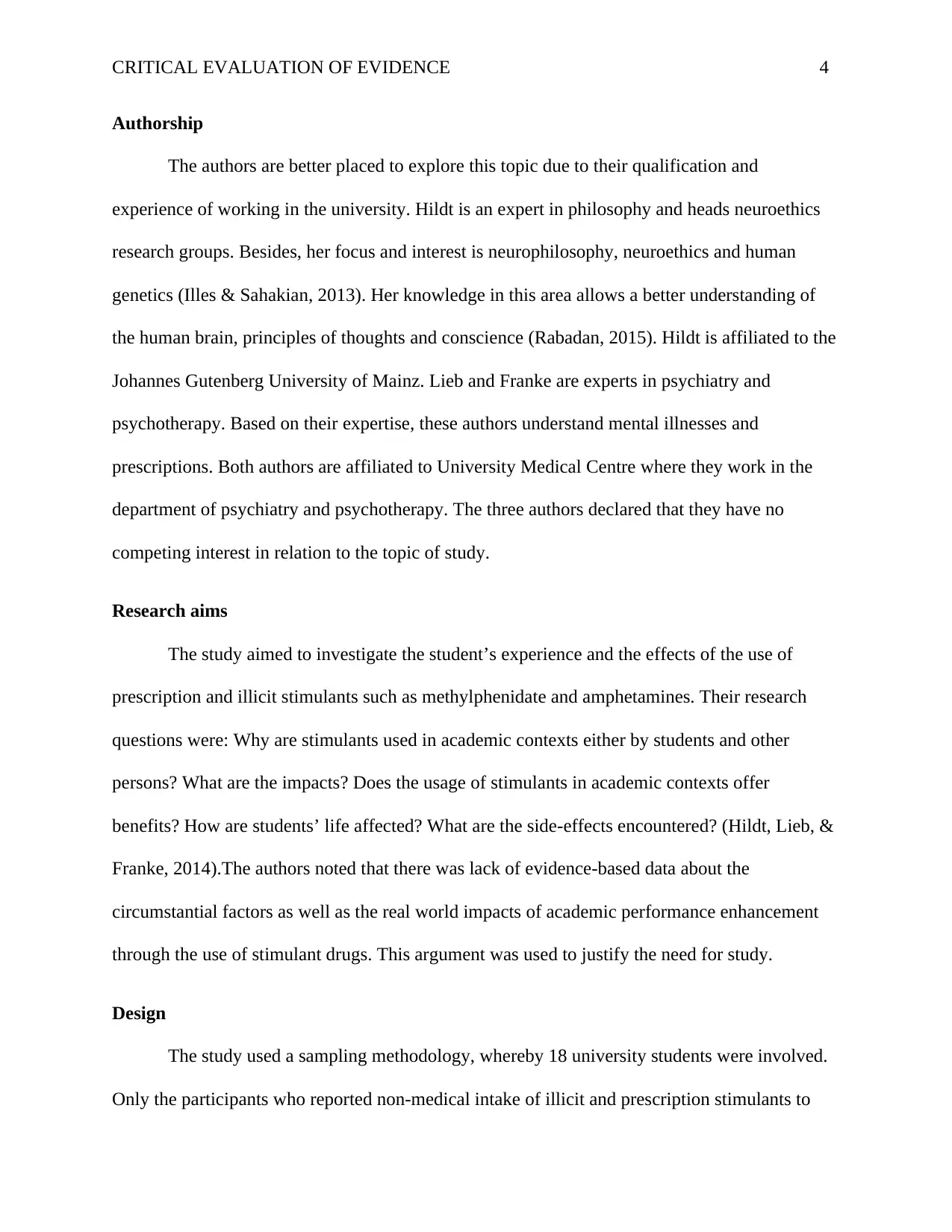
CRITICAL EVALUATION OF EVIDENCE 4
Authorship
The authors are better placed to explore this topic due to their qualification and
experience of working in the university. Hildt is an expert in philosophy and heads neuroethics
research groups. Besides, her focus and interest is neurophilosophy, neuroethics and human
genetics (Illes & Sahakian, 2013). Her knowledge in this area allows a better understanding of
the human brain, principles of thoughts and conscience (Rabadan, 2015). Hildt is affiliated to the
Johannes Gutenberg University of Mainz. Lieb and Franke are experts in psychiatry and
psychotherapy. Based on their expertise, these authors understand mental illnesses and
prescriptions. Both authors are affiliated to University Medical Centre where they work in the
department of psychiatry and psychotherapy. The three authors declared that they have no
competing interest in relation to the topic of study.
Research aims
The study aimed to investigate the student’s experience and the effects of the use of
prescription and illicit stimulants such as methylphenidate and amphetamines. Their research
questions were: Why are stimulants used in academic contexts either by students and other
persons? What are the impacts? Does the usage of stimulants in academic contexts offer
benefits? How are students’ life affected? What are the side-effects encountered? (Hildt, Lieb, &
Franke, 2014).The authors noted that there was lack of evidence-based data about the
circumstantial factors as well as the real world impacts of academic performance enhancement
through the use of stimulant drugs. This argument was used to justify the need for study.
Design
The study used a sampling methodology, whereby 18 university students were involved.
Only the participants who reported non-medical intake of illicit and prescription stimulants to
Authorship
The authors are better placed to explore this topic due to their qualification and
experience of working in the university. Hildt is an expert in philosophy and heads neuroethics
research groups. Besides, her focus and interest is neurophilosophy, neuroethics and human
genetics (Illes & Sahakian, 2013). Her knowledge in this area allows a better understanding of
the human brain, principles of thoughts and conscience (Rabadan, 2015). Hildt is affiliated to the
Johannes Gutenberg University of Mainz. Lieb and Franke are experts in psychiatry and
psychotherapy. Based on their expertise, these authors understand mental illnesses and
prescriptions. Both authors are affiliated to University Medical Centre where they work in the
department of psychiatry and psychotherapy. The three authors declared that they have no
competing interest in relation to the topic of study.
Research aims
The study aimed to investigate the student’s experience and the effects of the use of
prescription and illicit stimulants such as methylphenidate and amphetamines. Their research
questions were: Why are stimulants used in academic contexts either by students and other
persons? What are the impacts? Does the usage of stimulants in academic contexts offer
benefits? How are students’ life affected? What are the side-effects encountered? (Hildt, Lieb, &
Franke, 2014).The authors noted that there was lack of evidence-based data about the
circumstantial factors as well as the real world impacts of academic performance enhancement
through the use of stimulant drugs. This argument was used to justify the need for study.
Design
The study used a sampling methodology, whereby 18 university students were involved.
Only the participants who reported non-medical intake of illicit and prescription stimulants to
Paraphrase This Document
Need a fresh take? Get an instant paraphrase of this document with our AI Paraphraser
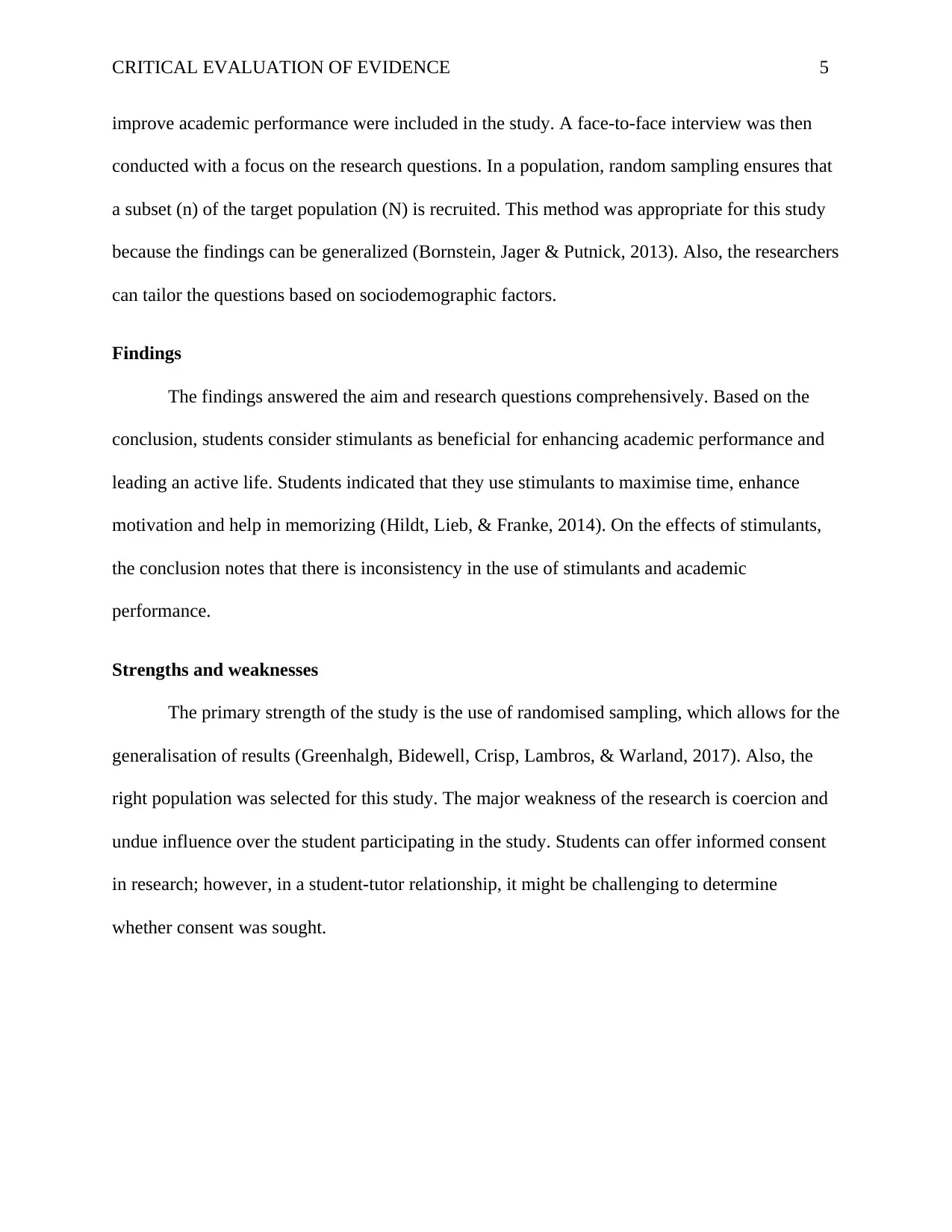
CRITICAL EVALUATION OF EVIDENCE 5
improve academic performance were included in the study. A face-to-face interview was then
conducted with a focus on the research questions. In a population, random sampling ensures that
a subset (n) of the target population (N) is recruited. This method was appropriate for this study
because the findings can be generalized (Bornstein, Jager & Putnick, 2013). Also, the researchers
can tailor the questions based on sociodemographic factors.
Findings
The findings answered the aim and research questions comprehensively. Based on the
conclusion, students consider stimulants as beneficial for enhancing academic performance and
leading an active life. Students indicated that they use stimulants to maximise time, enhance
motivation and help in memorizing (Hildt, Lieb, & Franke, 2014). On the effects of stimulants,
the conclusion notes that there is inconsistency in the use of stimulants and academic
performance.
Strengths and weaknesses
The primary strength of the study is the use of randomised sampling, which allows for the
generalisation of results (Greenhalgh, Bidewell, Crisp, Lambros, & Warland, 2017). Also, the
right population was selected for this study. The major weakness of the research is coercion and
undue influence over the student participating in the study. Students can offer informed consent
in research; however, in a student-tutor relationship, it might be challenging to determine
whether consent was sought.
improve academic performance were included in the study. A face-to-face interview was then
conducted with a focus on the research questions. In a population, random sampling ensures that
a subset (n) of the target population (N) is recruited. This method was appropriate for this study
because the findings can be generalized (Bornstein, Jager & Putnick, 2013). Also, the researchers
can tailor the questions based on sociodemographic factors.
Findings
The findings answered the aim and research questions comprehensively. Based on the
conclusion, students consider stimulants as beneficial for enhancing academic performance and
leading an active life. Students indicated that they use stimulants to maximise time, enhance
motivation and help in memorizing (Hildt, Lieb, & Franke, 2014). On the effects of stimulants,
the conclusion notes that there is inconsistency in the use of stimulants and academic
performance.
Strengths and weaknesses
The primary strength of the study is the use of randomised sampling, which allows for the
generalisation of results (Greenhalgh, Bidewell, Crisp, Lambros, & Warland, 2017). Also, the
right population was selected for this study. The major weakness of the research is coercion and
undue influence over the student participating in the study. Students can offer informed consent
in research; however, in a student-tutor relationship, it might be challenging to determine
whether consent was sought.
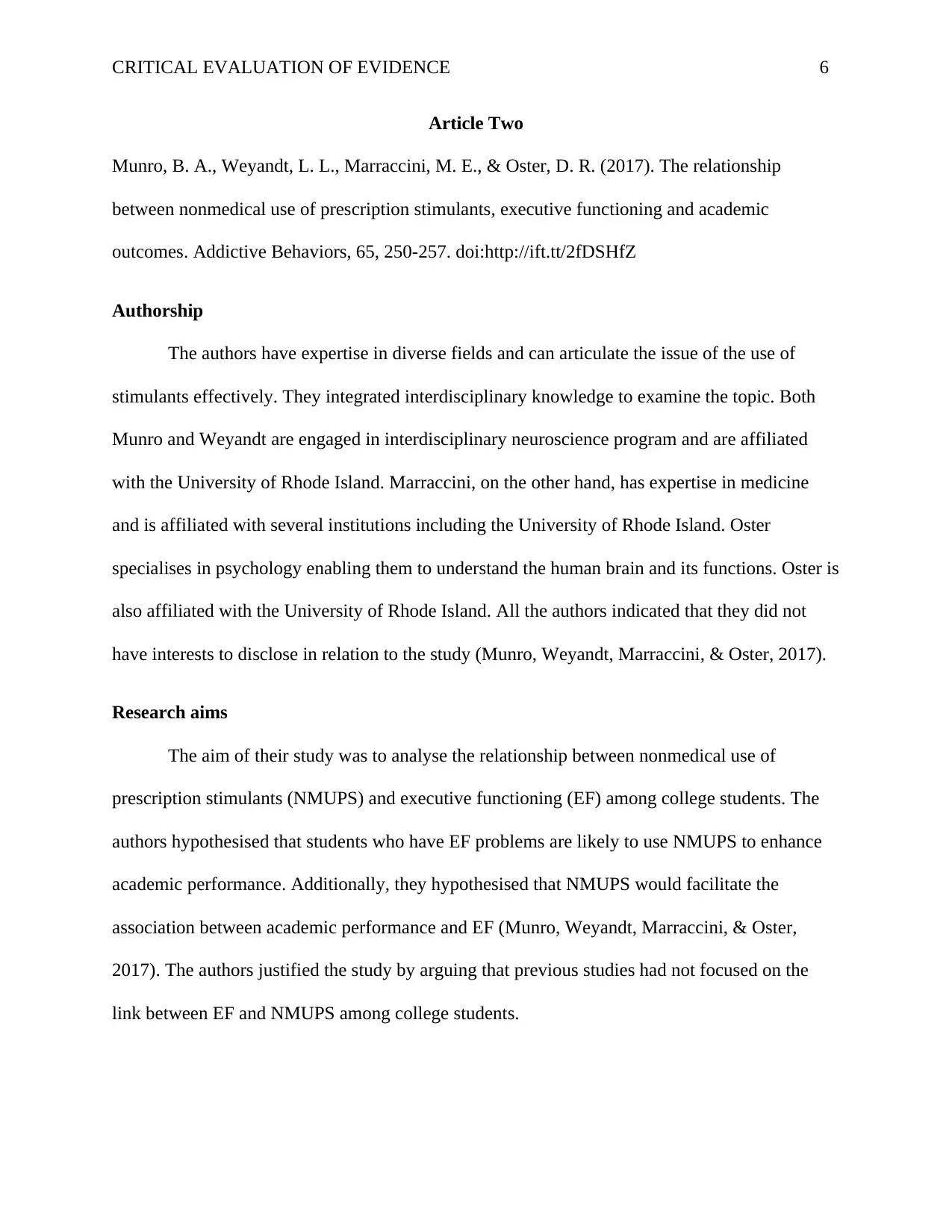
CRITICAL EVALUATION OF EVIDENCE 6
Article Two
Munro, B. A., Weyandt, L. L., Marraccini, M. E., & Oster, D. R. (2017). The relationship
between nonmedical use of prescription stimulants, executive functioning and academic
outcomes. Addictive Behaviors, 65, 250-257. doi:http://ift.tt/2fDSHfZ
Authorship
The authors have expertise in diverse fields and can articulate the issue of the use of
stimulants effectively. They integrated interdisciplinary knowledge to examine the topic. Both
Munro and Weyandt are engaged in interdisciplinary neuroscience program and are affiliated
with the University of Rhode Island. Marraccini, on the other hand, has expertise in medicine
and is affiliated with several institutions including the University of Rhode Island. Oster
specialises in psychology enabling them to understand the human brain and its functions. Oster is
also affiliated with the University of Rhode Island. All the authors indicated that they did not
have interests to disclose in relation to the study (Munro, Weyandt, Marraccini, & Oster, 2017).
Research aims
The aim of their study was to analyse the relationship between nonmedical use of
prescription stimulants (NMUPS) and executive functioning (EF) among college students. The
authors hypothesised that students who have EF problems are likely to use NMUPS to enhance
academic performance. Additionally, they hypothesised that NMUPS would facilitate the
association between academic performance and EF (Munro, Weyandt, Marraccini, & Oster,
2017). The authors justified the study by arguing that previous studies had not focused on the
link between EF and NMUPS among college students.
Article Two
Munro, B. A., Weyandt, L. L., Marraccini, M. E., & Oster, D. R. (2017). The relationship
between nonmedical use of prescription stimulants, executive functioning and academic
outcomes. Addictive Behaviors, 65, 250-257. doi:http://ift.tt/2fDSHfZ
Authorship
The authors have expertise in diverse fields and can articulate the issue of the use of
stimulants effectively. They integrated interdisciplinary knowledge to examine the topic. Both
Munro and Weyandt are engaged in interdisciplinary neuroscience program and are affiliated
with the University of Rhode Island. Marraccini, on the other hand, has expertise in medicine
and is affiliated with several institutions including the University of Rhode Island. Oster
specialises in psychology enabling them to understand the human brain and its functions. Oster is
also affiliated with the University of Rhode Island. All the authors indicated that they did not
have interests to disclose in relation to the study (Munro, Weyandt, Marraccini, & Oster, 2017).
Research aims
The aim of their study was to analyse the relationship between nonmedical use of
prescription stimulants (NMUPS) and executive functioning (EF) among college students. The
authors hypothesised that students who have EF problems are likely to use NMUPS to enhance
academic performance. Additionally, they hypothesised that NMUPS would facilitate the
association between academic performance and EF (Munro, Weyandt, Marraccini, & Oster,
2017). The authors justified the study by arguing that previous studies had not focused on the
link between EF and NMUPS among college students.
⊘ This is a preview!⊘
Do you want full access?
Subscribe today to unlock all pages.

Trusted by 1+ million students worldwide
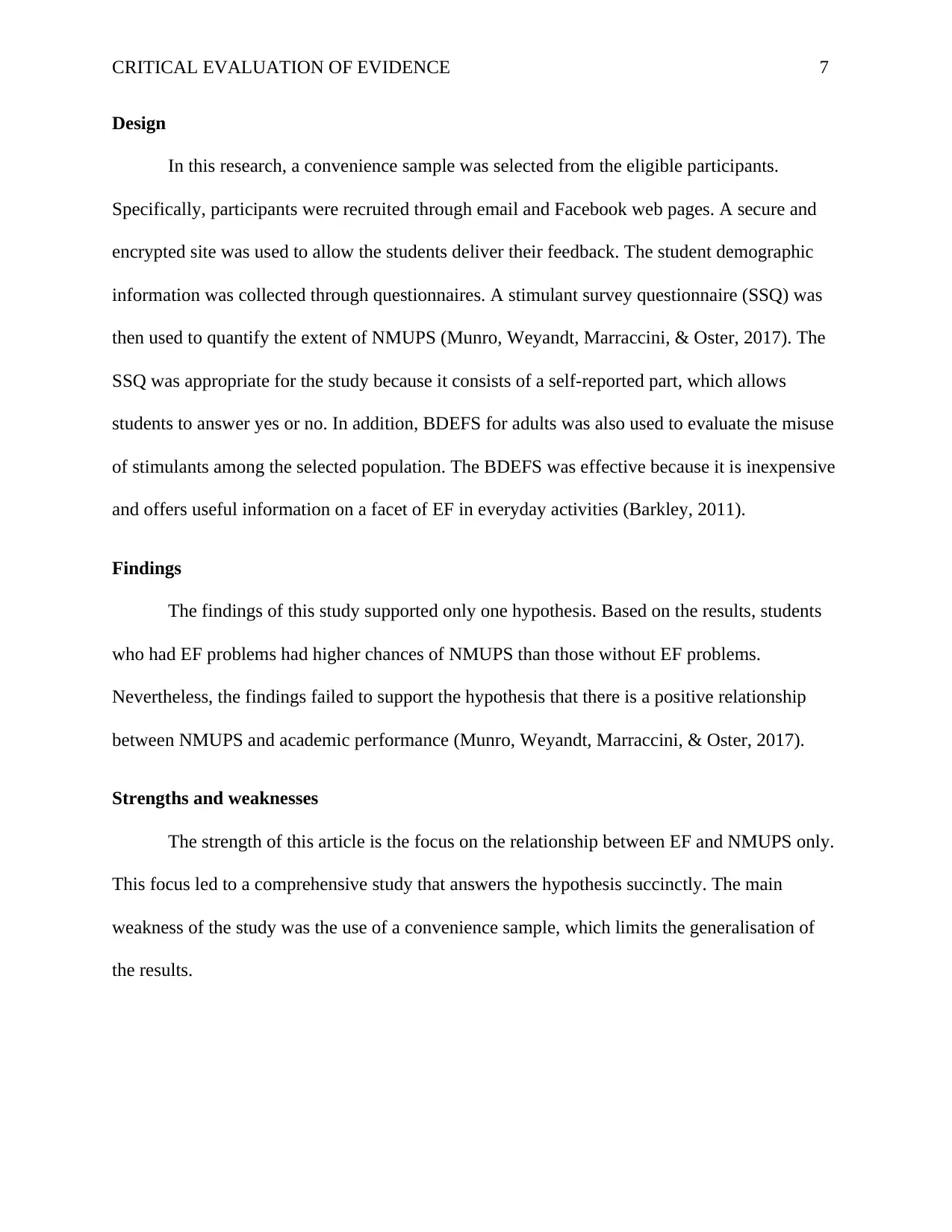
CRITICAL EVALUATION OF EVIDENCE 7
Design
In this research, a convenience sample was selected from the eligible participants.
Specifically, participants were recruited through email and Facebook web pages. A secure and
encrypted site was used to allow the students deliver their feedback. The student demographic
information was collected through questionnaires. A stimulant survey questionnaire (SSQ) was
then used to quantify the extent of NMUPS (Munro, Weyandt, Marraccini, & Oster, 2017). The
SSQ was appropriate for the study because it consists of a self-reported part, which allows
students to answer yes or no. In addition, BDEFS for adults was also used to evaluate the misuse
of stimulants among the selected population. The BDEFS was effective because it is inexpensive
and offers useful information on a facet of EF in everyday activities (Barkley, 2011).
Findings
The findings of this study supported only one hypothesis. Based on the results, students
who had EF problems had higher chances of NMUPS than those without EF problems.
Nevertheless, the findings failed to support the hypothesis that there is a positive relationship
between NMUPS and academic performance (Munro, Weyandt, Marraccini, & Oster, 2017).
Strengths and weaknesses
The strength of this article is the focus on the relationship between EF and NMUPS only.
This focus led to a comprehensive study that answers the hypothesis succinctly. The main
weakness of the study was the use of a convenience sample, which limits the generalisation of
the results.
Design
In this research, a convenience sample was selected from the eligible participants.
Specifically, participants were recruited through email and Facebook web pages. A secure and
encrypted site was used to allow the students deliver their feedback. The student demographic
information was collected through questionnaires. A stimulant survey questionnaire (SSQ) was
then used to quantify the extent of NMUPS (Munro, Weyandt, Marraccini, & Oster, 2017). The
SSQ was appropriate for the study because it consists of a self-reported part, which allows
students to answer yes or no. In addition, BDEFS for adults was also used to evaluate the misuse
of stimulants among the selected population. The BDEFS was effective because it is inexpensive
and offers useful information on a facet of EF in everyday activities (Barkley, 2011).
Findings
The findings of this study supported only one hypothesis. Based on the results, students
who had EF problems had higher chances of NMUPS than those without EF problems.
Nevertheless, the findings failed to support the hypothesis that there is a positive relationship
between NMUPS and academic performance (Munro, Weyandt, Marraccini, & Oster, 2017).
Strengths and weaknesses
The strength of this article is the focus on the relationship between EF and NMUPS only.
This focus led to a comprehensive study that answers the hypothesis succinctly. The main
weakness of the study was the use of a convenience sample, which limits the generalisation of
the results.
Paraphrase This Document
Need a fresh take? Get an instant paraphrase of this document with our AI Paraphraser
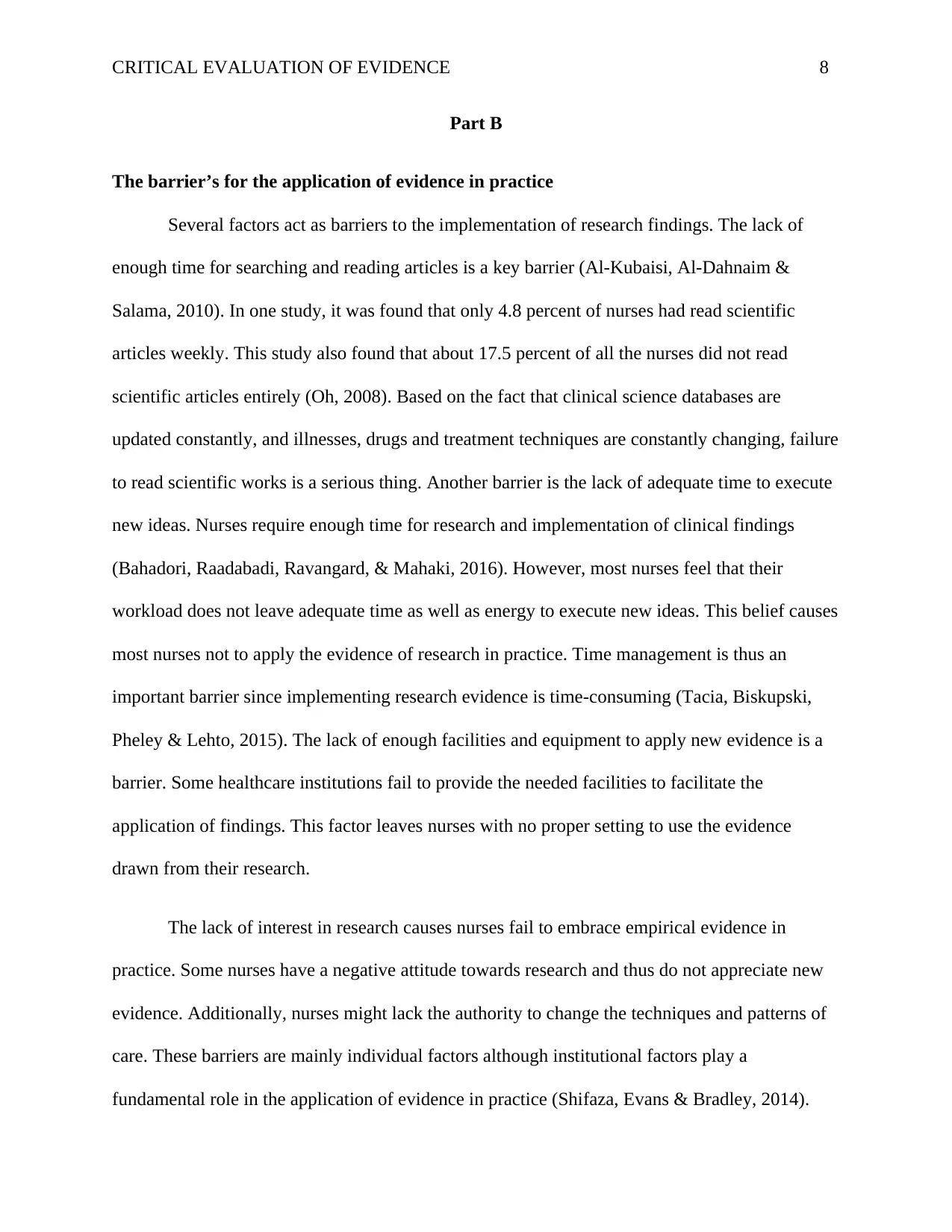
CRITICAL EVALUATION OF EVIDENCE 8
Part B
The barrier’s for the application of evidence in practice
Several factors act as barriers to the implementation of research findings. The lack of
enough time for searching and reading articles is a key barrier (Al-Kubaisi, Al-Dahnaim &
Salama, 2010). In one study, it was found that only 4.8 percent of nurses had read scientific
articles weekly. This study also found that about 17.5 percent of all the nurses did not read
scientific articles entirely (Oh, 2008). Based on the fact that clinical science databases are
updated constantly, and illnesses, drugs and treatment techniques are constantly changing, failure
to read scientific works is a serious thing. Another barrier is the lack of adequate time to execute
new ideas. Nurses require enough time for research and implementation of clinical findings
(Bahadori, Raadabadi, Ravangard, & Mahaki, 2016). However, most nurses feel that their
workload does not leave adequate time as well as energy to execute new ideas. This belief causes
most nurses not to apply the evidence of research in practice. Time management is thus an
important barrier since implementing research evidence is time-consuming (Tacia, Biskupski,
Pheley & Lehto, 2015). The lack of enough facilities and equipment to apply new evidence is a
barrier. Some healthcare institutions fail to provide the needed facilities to facilitate the
application of findings. This factor leaves nurses with no proper setting to use the evidence
drawn from their research.
The lack of interest in research causes nurses fail to embrace empirical evidence in
practice. Some nurses have a negative attitude towards research and thus do not appreciate new
evidence. Additionally, nurses might lack the authority to change the techniques and patterns of
care. These barriers are mainly individual factors although institutional factors play a
fundamental role in the application of evidence in practice (Shifaza, Evans & Bradley, 2014).
Part B
The barrier’s for the application of evidence in practice
Several factors act as barriers to the implementation of research findings. The lack of
enough time for searching and reading articles is a key barrier (Al-Kubaisi, Al-Dahnaim &
Salama, 2010). In one study, it was found that only 4.8 percent of nurses had read scientific
articles weekly. This study also found that about 17.5 percent of all the nurses did not read
scientific articles entirely (Oh, 2008). Based on the fact that clinical science databases are
updated constantly, and illnesses, drugs and treatment techniques are constantly changing, failure
to read scientific works is a serious thing. Another barrier is the lack of adequate time to execute
new ideas. Nurses require enough time for research and implementation of clinical findings
(Bahadori, Raadabadi, Ravangard, & Mahaki, 2016). However, most nurses feel that their
workload does not leave adequate time as well as energy to execute new ideas. This belief causes
most nurses not to apply the evidence of research in practice. Time management is thus an
important barrier since implementing research evidence is time-consuming (Tacia, Biskupski,
Pheley & Lehto, 2015). The lack of enough facilities and equipment to apply new evidence is a
barrier. Some healthcare institutions fail to provide the needed facilities to facilitate the
application of findings. This factor leaves nurses with no proper setting to use the evidence
drawn from their research.
The lack of interest in research causes nurses fail to embrace empirical evidence in
practice. Some nurses have a negative attitude towards research and thus do not appreciate new
evidence. Additionally, nurses might lack the authority to change the techniques and patterns of
care. These barriers are mainly individual factors although institutional factors play a
fundamental role in the application of evidence in practice (Shifaza, Evans & Bradley, 2014).
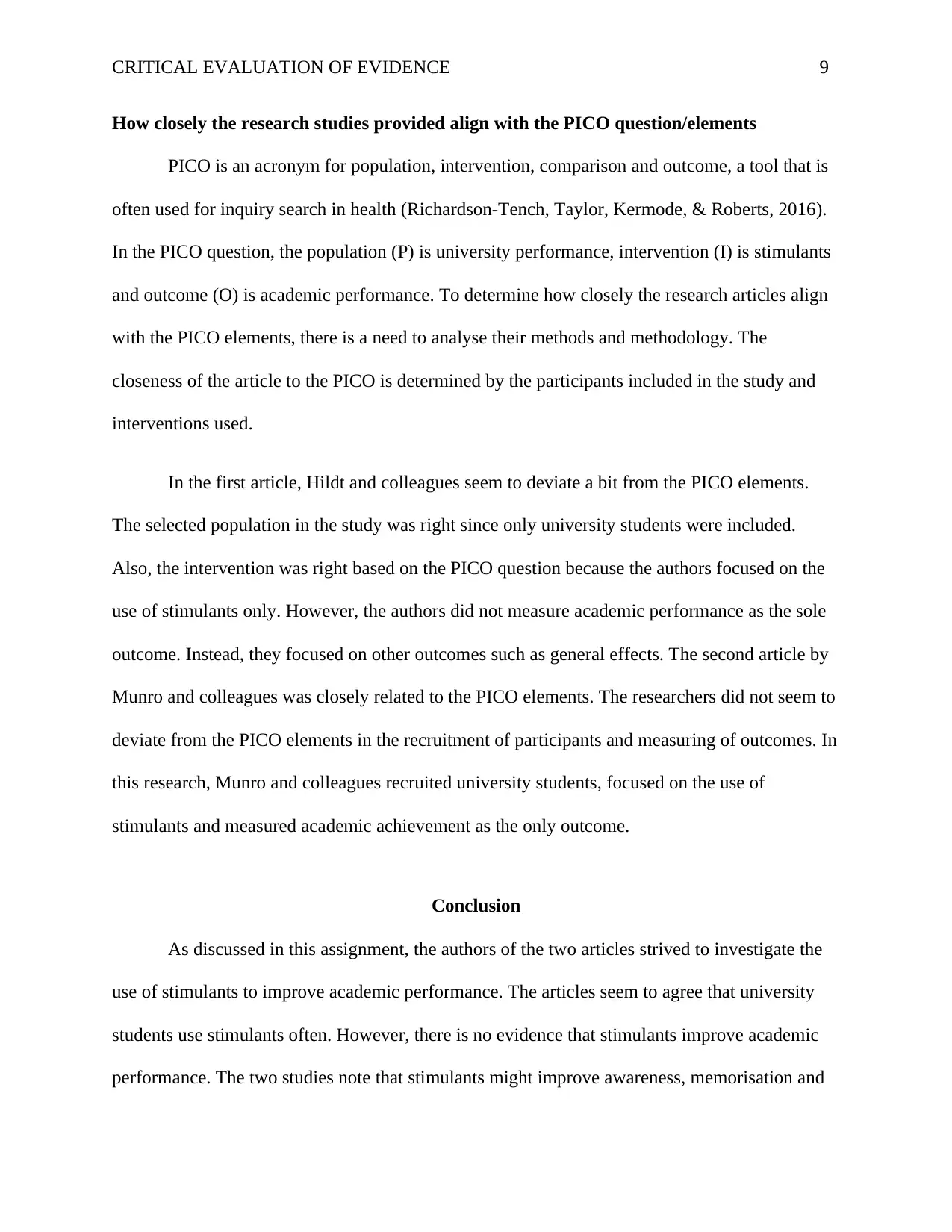
CRITICAL EVALUATION OF EVIDENCE 9
How closely the research studies provided align with the PICO question/elements
PICO is an acronym for population, intervention, comparison and outcome, a tool that is
often used for inquiry search in health (Richardson-Tench, Taylor, Kermode, & Roberts, 2016).
In the PICO question, the population (P) is university performance, intervention (I) is stimulants
and outcome (O) is academic performance. To determine how closely the research articles align
with the PICO elements, there is a need to analyse their methods and methodology. The
closeness of the article to the PICO is determined by the participants included in the study and
interventions used.
In the first article, Hildt and colleagues seem to deviate a bit from the PICO elements.
The selected population in the study was right since only university students were included.
Also, the intervention was right based on the PICO question because the authors focused on the
use of stimulants only. However, the authors did not measure academic performance as the sole
outcome. Instead, they focused on other outcomes such as general effects. The second article by
Munro and colleagues was closely related to the PICO elements. The researchers did not seem to
deviate from the PICO elements in the recruitment of participants and measuring of outcomes. In
this research, Munro and colleagues recruited university students, focused on the use of
stimulants and measured academic achievement as the only outcome.
Conclusion
As discussed in this assignment, the authors of the two articles strived to investigate the
use of stimulants to improve academic performance. The articles seem to agree that university
students use stimulants often. However, there is no evidence that stimulants improve academic
performance. The two studies note that stimulants might improve awareness, memorisation and
How closely the research studies provided align with the PICO question/elements
PICO is an acronym for population, intervention, comparison and outcome, a tool that is
often used for inquiry search in health (Richardson-Tench, Taylor, Kermode, & Roberts, 2016).
In the PICO question, the population (P) is university performance, intervention (I) is stimulants
and outcome (O) is academic performance. To determine how closely the research articles align
with the PICO elements, there is a need to analyse their methods and methodology. The
closeness of the article to the PICO is determined by the participants included in the study and
interventions used.
In the first article, Hildt and colleagues seem to deviate a bit from the PICO elements.
The selected population in the study was right since only university students were included.
Also, the intervention was right based on the PICO question because the authors focused on the
use of stimulants only. However, the authors did not measure academic performance as the sole
outcome. Instead, they focused on other outcomes such as general effects. The second article by
Munro and colleagues was closely related to the PICO elements. The researchers did not seem to
deviate from the PICO elements in the recruitment of participants and measuring of outcomes. In
this research, Munro and colleagues recruited university students, focused on the use of
stimulants and measured academic achievement as the only outcome.
Conclusion
As discussed in this assignment, the authors of the two articles strived to investigate the
use of stimulants to improve academic performance. The articles seem to agree that university
students use stimulants often. However, there is no evidence that stimulants improve academic
performance. The two studies note that stimulants might improve awareness, memorisation and
⊘ This is a preview!⊘
Do you want full access?
Subscribe today to unlock all pages.

Trusted by 1+ million students worldwide
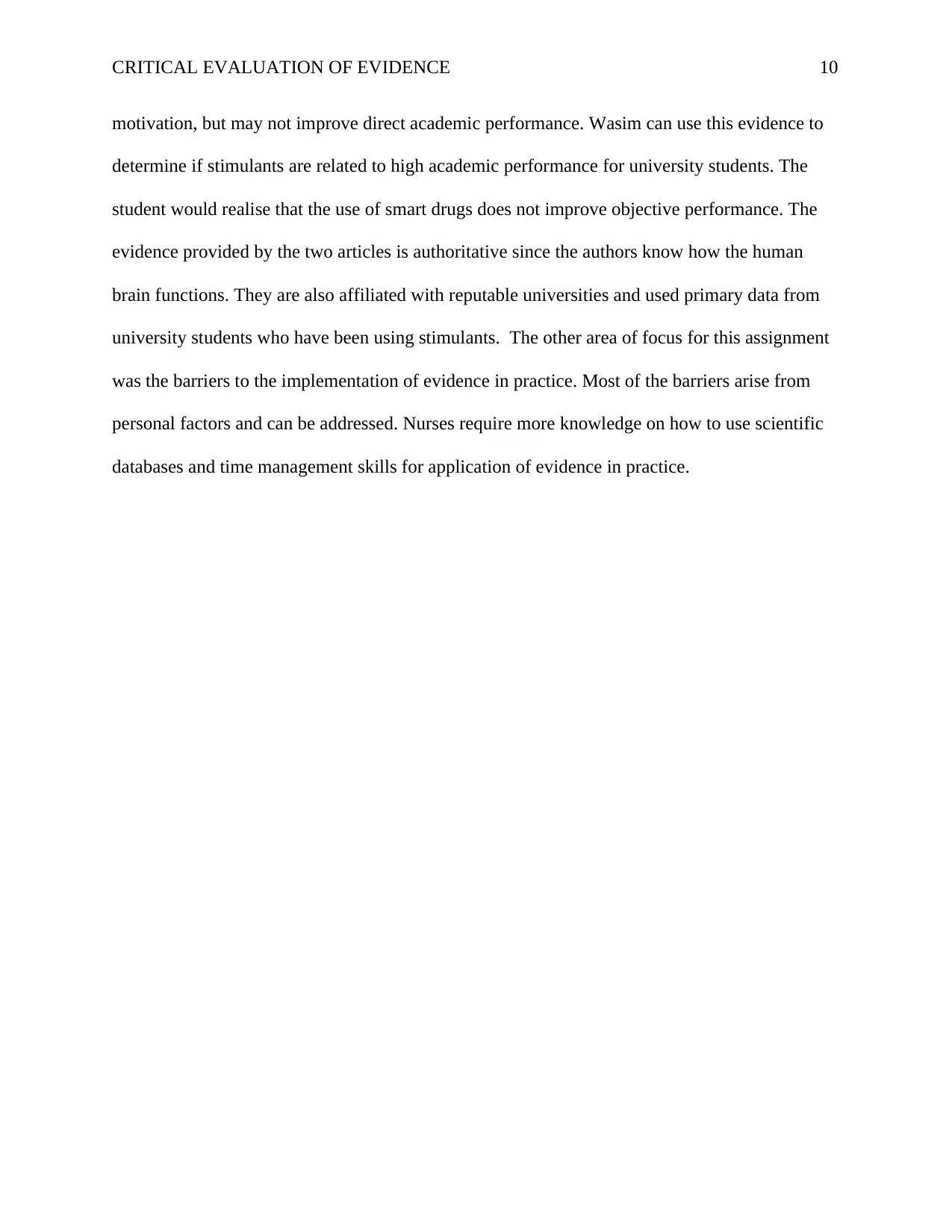
CRITICAL EVALUATION OF EVIDENCE 10
motivation, but may not improve direct academic performance. Wasim can use this evidence to
determine if stimulants are related to high academic performance for university students. The
student would realise that the use of smart drugs does not improve objective performance. The
evidence provided by the two articles is authoritative since the authors know how the human
brain functions. They are also affiliated with reputable universities and used primary data from
university students who have been using stimulants. The other area of focus for this assignment
was the barriers to the implementation of evidence in practice. Most of the barriers arise from
personal factors and can be addressed. Nurses require more knowledge on how to use scientific
databases and time management skills for application of evidence in practice.
motivation, but may not improve direct academic performance. Wasim can use this evidence to
determine if stimulants are related to high academic performance for university students. The
student would realise that the use of smart drugs does not improve objective performance. The
evidence provided by the two articles is authoritative since the authors know how the human
brain functions. They are also affiliated with reputable universities and used primary data from
university students who have been using stimulants. The other area of focus for this assignment
was the barriers to the implementation of evidence in practice. Most of the barriers arise from
personal factors and can be addressed. Nurses require more knowledge on how to use scientific
databases and time management skills for application of evidence in practice.
Paraphrase This Document
Need a fresh take? Get an instant paraphrase of this document with our AI Paraphraser
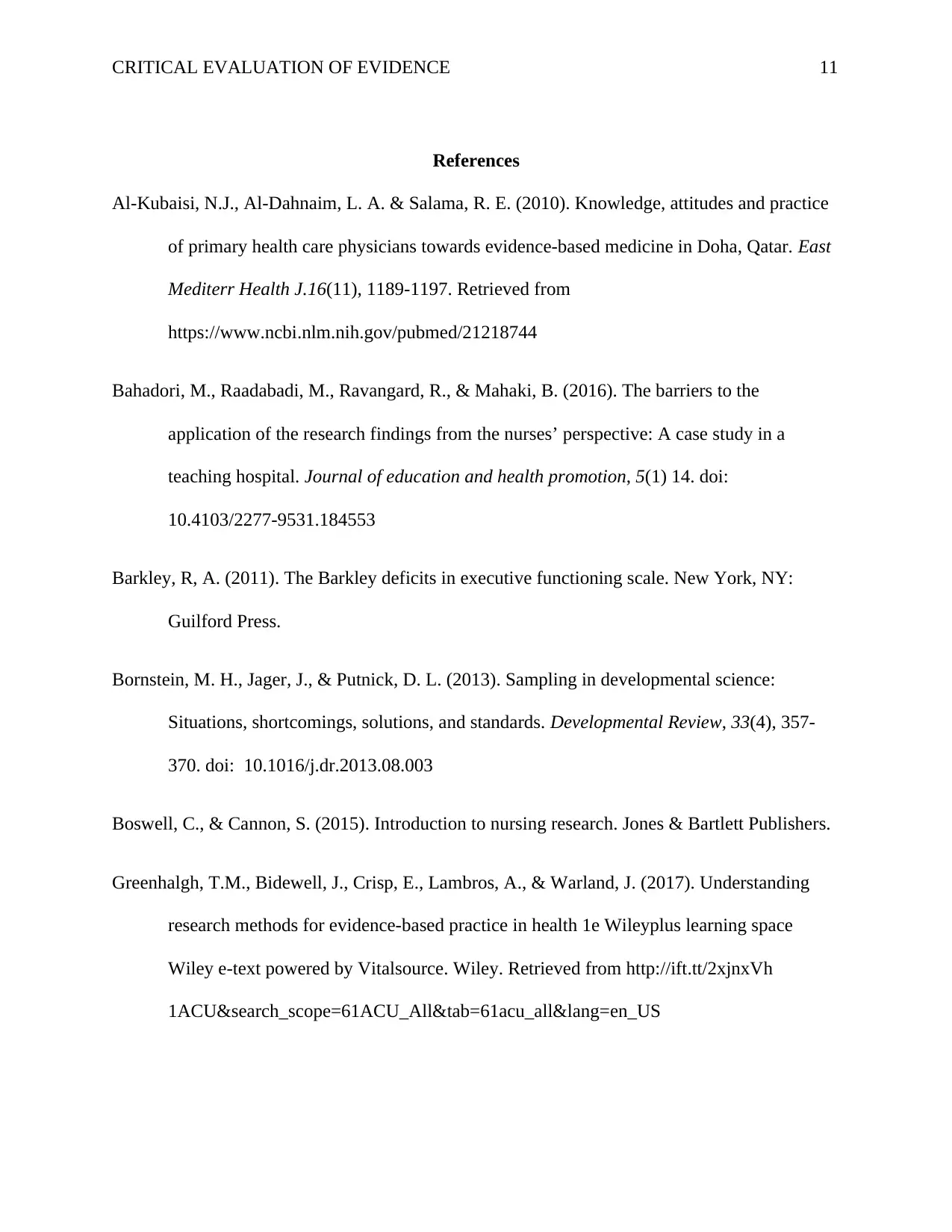
CRITICAL EVALUATION OF EVIDENCE 11
References
Al-Kubaisi, N.J., Al-Dahnaim, L. A. & Salama, R. E. (2010). Knowledge, attitudes and practice
of primary health care physicians towards evidence-based medicine in Doha, Qatar. East
Mediterr Health J.16(11), 1189-1197. Retrieved from
https://www.ncbi.nlm.nih.gov/pubmed/21218744
Bahadori, M., Raadabadi, M., Ravangard, R., & Mahaki, B. (2016). The barriers to the
application of the research findings from the nurses’ perspective: A case study in a
teaching hospital. Journal of education and health promotion, 5(1) 14. doi:
10.4103/2277-9531.184553
Barkley, R, A. (2011). The Barkley deficits in executive functioning scale. New York, NY:
Guilford Press.
Bornstein, M. H., Jager, J., & Putnick, D. L. (2013). Sampling in developmental science:
Situations, shortcomings, solutions, and standards. Developmental Review, 33(4), 357-
370. doi: 10.1016/j.dr.2013.08.003
Boswell, C., & Cannon, S. (2015). Introduction to nursing research. Jones & Bartlett Publishers.
Greenhalgh, T.M., Bidewell, J., Crisp, E., Lambros, A., & Warland, J. (2017). Understanding
research methods for evidence-based practice in health 1e Wileyplus learning space
Wiley e-text powered by Vitalsource. Wiley. Retrieved from http://ift.tt/2xjnxVh
1ACU&search_scope=61ACU_All&tab=61acu_all&lang=en_US
References
Al-Kubaisi, N.J., Al-Dahnaim, L. A. & Salama, R. E. (2010). Knowledge, attitudes and practice
of primary health care physicians towards evidence-based medicine in Doha, Qatar. East
Mediterr Health J.16(11), 1189-1197. Retrieved from
https://www.ncbi.nlm.nih.gov/pubmed/21218744
Bahadori, M., Raadabadi, M., Ravangard, R., & Mahaki, B. (2016). The barriers to the
application of the research findings from the nurses’ perspective: A case study in a
teaching hospital. Journal of education and health promotion, 5(1) 14. doi:
10.4103/2277-9531.184553
Barkley, R, A. (2011). The Barkley deficits in executive functioning scale. New York, NY:
Guilford Press.
Bornstein, M. H., Jager, J., & Putnick, D. L. (2013). Sampling in developmental science:
Situations, shortcomings, solutions, and standards. Developmental Review, 33(4), 357-
370. doi: 10.1016/j.dr.2013.08.003
Boswell, C., & Cannon, S. (2015). Introduction to nursing research. Jones & Bartlett Publishers.
Greenhalgh, T.M., Bidewell, J., Crisp, E., Lambros, A., & Warland, J. (2017). Understanding
research methods for evidence-based practice in health 1e Wileyplus learning space
Wiley e-text powered by Vitalsource. Wiley. Retrieved from http://ift.tt/2xjnxVh
1ACU&search_scope=61ACU_All&tab=61acu_all&lang=en_US
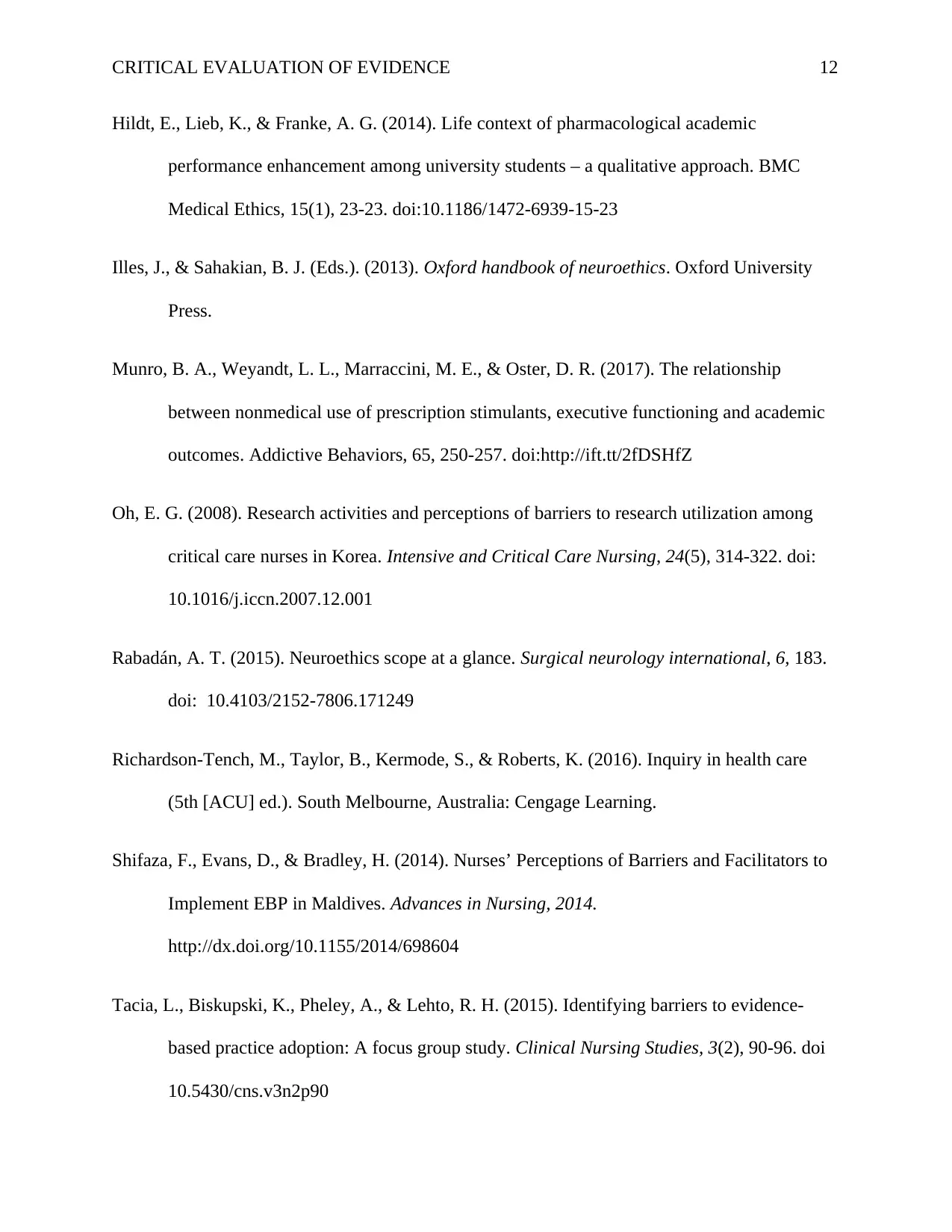
CRITICAL EVALUATION OF EVIDENCE 12
Hildt, E., Lieb, K., & Franke, A. G. (2014). Life context of pharmacological academic
performance enhancement among university students – a qualitative approach. BMC
Medical Ethics, 15(1), 23-23. doi:10.1186/1472-6939-15-23
Illes, J., & Sahakian, B. J. (Eds.). (2013). Oxford handbook of neuroethics. Oxford University
Press.
Munro, B. A., Weyandt, L. L., Marraccini, M. E., & Oster, D. R. (2017). The relationship
between nonmedical use of prescription stimulants, executive functioning and academic
outcomes. Addictive Behaviors, 65, 250-257. doi:http://ift.tt/2fDSHfZ
Oh, E. G. (2008). Research activities and perceptions of barriers to research utilization among
critical care nurses in Korea. Intensive and Critical Care Nursing, 24(5), 314-322. doi:
10.1016/j.iccn.2007.12.001
Rabadán, A. T. (2015). Neuroethics scope at a glance. Surgical neurology international, 6, 183.
doi: 10.4103/2152-7806.171249
Richardson-Tench, M., Taylor, B., Kermode, S., & Roberts, K. (2016). Inquiry in health care
(5th [ACU] ed.). South Melbourne, Australia: Cengage Learning.
Shifaza, F., Evans, D., & Bradley, H. (2014). Nurses’ Perceptions of Barriers and Facilitators to
Implement EBP in Maldives. Advances in Nursing, 2014.
http://dx.doi.org/10.1155/2014/698604
Tacia, L., Biskupski, K., Pheley, A., & Lehto, R. H. (2015). Identifying barriers to evidence-
based practice adoption: A focus group study. Clinical Nursing Studies, 3(2), 90-96. doi
10.5430/cns.v3n2p90
Hildt, E., Lieb, K., & Franke, A. G. (2014). Life context of pharmacological academic
performance enhancement among university students – a qualitative approach. BMC
Medical Ethics, 15(1), 23-23. doi:10.1186/1472-6939-15-23
Illes, J., & Sahakian, B. J. (Eds.). (2013). Oxford handbook of neuroethics. Oxford University
Press.
Munro, B. A., Weyandt, L. L., Marraccini, M. E., & Oster, D. R. (2017). The relationship
between nonmedical use of prescription stimulants, executive functioning and academic
outcomes. Addictive Behaviors, 65, 250-257. doi:http://ift.tt/2fDSHfZ
Oh, E. G. (2008). Research activities and perceptions of barriers to research utilization among
critical care nurses in Korea. Intensive and Critical Care Nursing, 24(5), 314-322. doi:
10.1016/j.iccn.2007.12.001
Rabadán, A. T. (2015). Neuroethics scope at a glance. Surgical neurology international, 6, 183.
doi: 10.4103/2152-7806.171249
Richardson-Tench, M., Taylor, B., Kermode, S., & Roberts, K. (2016). Inquiry in health care
(5th [ACU] ed.). South Melbourne, Australia: Cengage Learning.
Shifaza, F., Evans, D., & Bradley, H. (2014). Nurses’ Perceptions of Barriers and Facilitators to
Implement EBP in Maldives. Advances in Nursing, 2014.
http://dx.doi.org/10.1155/2014/698604
Tacia, L., Biskupski, K., Pheley, A., & Lehto, R. H. (2015). Identifying barriers to evidence-
based practice adoption: A focus group study. Clinical Nursing Studies, 3(2), 90-96. doi
10.5430/cns.v3n2p90
⊘ This is a preview!⊘
Do you want full access?
Subscribe today to unlock all pages.

Trusted by 1+ million students worldwide
1 out of 12
Related Documents
Your All-in-One AI-Powered Toolkit for Academic Success.
+13062052269
info@desklib.com
Available 24*7 on WhatsApp / Email
![[object Object]](/_next/static/media/star-bottom.7253800d.svg)
Unlock your academic potential
Copyright © 2020–2025 A2Z Services. All Rights Reserved. Developed and managed by ZUCOL.





